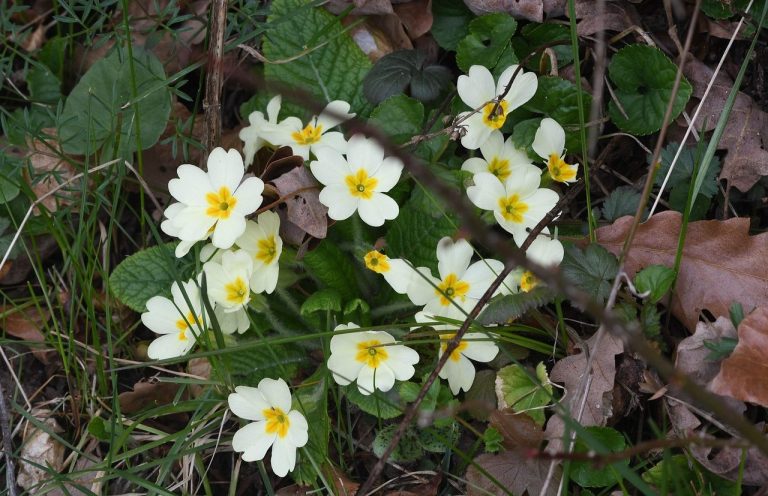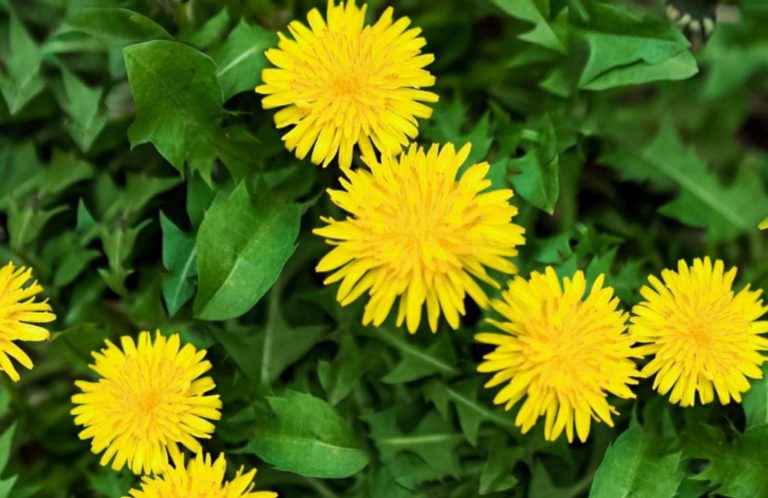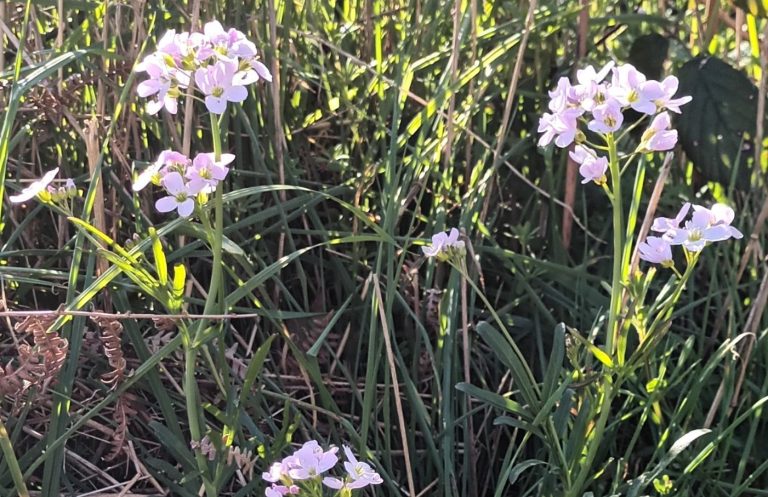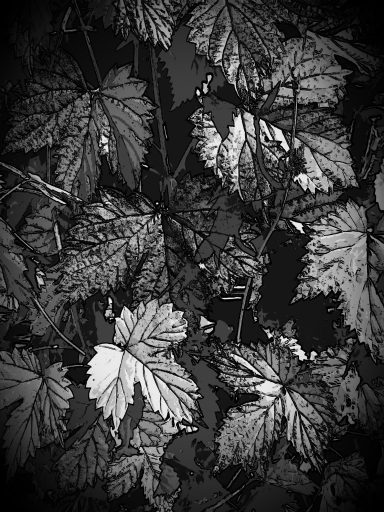Around and about.
Take a wander around the lanes that make up the village of Hellingly and you will find a host of wildflowers just waiting to be discovered. Spring into early summer are the most bountiful periods.
More to come as the seasons change.

Primrose
Primula vulgaris
The Primrose is one of the first Spring blooms hence the root of its name “Prima rosa”. More commonly the flower is pale yellow with a deeper yellow eye though various sports may appear. Some occur naturally and some are escapees from gardens. Either way they are a delight to behold en masse. It is of little surprise that elder Statesman and former Prime Minister Benjamin Disraeli listed the Primrose as his favourite flower. It is for this reason that his death on April 19th 1881 became marked by the wearing of Primroses in button holes, hats or any other appropriate item of wear.
Many country folk would supplement their household income by picking and selling these ubiquitous little flowers. They were not always just picked for profit, it was customary to decorate churches with Primroses during Easter and no bride marrying at that time would be without a posy or two. Whilst we are in the realms of Easter, Primroses were used along with other early spring flowers to decorate Pasche eggs.

Dandelion.
Taraxacum officinale.
The Dandelion was grown in greenhouses as a salad plant, Dandelion sandwiches being as popular then as our dainty cucumber sandwich is today. The flowers are edible and add colour to any salad. The root can be used to make tea and is said to have many health benefits. In fact many herbal products today include Dandelion root as it is an anti-inflammatory, antioxidant and antibacterial. According to those that know, the Dandelion is making its way back into favour in pubs and restaurants, not just because of its acquired taste but for its health benefits. When I recall the grubby leaves that I plucked from the hedgerow I can’t say that I am over enthused with the idea but what do I know? Just make sure that no dogs have recently passed that way.
However impressive the health credentials of the Dandelion might be, take a moment to study the flower itself. Dandelion is a corruption of “dent de lion”, Lion’s tooth. The flower is constructed of many slender, tooth like petals arranged in a fantastic and effective array.

Lesser Celandine.
Ranunculus ficaria.
It is not difficult to see that the Lesser Celandine is a relation of the Buttercup, with its vivid, glossy yellow petals. Where and when it grows the Lesser Celandine can be prolific and can create a carpet of Spring colour which is always a delight to behold.
The Celandine has tiny knobbly, tuberous roots which can be a problem to weed out of a bed or border. They break up easily and will re-grow from the tiniest little tuber. The Celandine was often used to treat haemorrhoids, whether there are any facts to this remedy I have no idea but the little groups of tubers are certainly reminiscent of piles, or so people tell me!
Many herbal products do contain Celandine though some times this is the Greater Celandine as opposed to the Lesser variety. The two plants are not related and do not look terribly similar.

Milkmaids.
Cardamine pratensis.
The trouble with C.pratensis is that it has so many vernacular names. I was born in Surrey to a mother from Kent and it was she that taught me name of Milkmaids. It could be that Sussex locals refer to it as Cuckooflower, Lady’s smocks, our Lady’s smocks or even Fairy Flower.
It is the Fairy flower name that gives away the place that this plant has in folklore. The Fairy folk regard this flower as sacred and so it will bring misfortune upon those who pick the flower. Therefore it was not the done thing to decorate ones home with Milkmaids or to include them in summer wreaths and garlands. At odds with this theory is the use of Milkmaids in Spring salads, the Milkmaid is a member of the cress family and the use of the plant for various remedial treatments. Ulcers, poor appetite, scurvy and kidney stones can all be eased by the good old Fairy flower. It is a fact that the plant does contain many beneficial chemical compounds used as antibacterials, antivirals, antidiabetics and anti-oxidants.

Forget-me-not.
Myosotis sylvatica.
There are several native varieties of Forget-me-not and countless crosses between cultivated varieties and wild plants which can make definite identification problematic. I have chosen to highlight the Wood Forget-me-not as it tends to have more blue flowers than it does pink flowers. The popular name was made famous by Samuel Taylor Coleridge and his poem “The Keepsake”. Prior to this the plant was more widely referred to as Scorpion grass, Water Forget-me-not (M.scorpioides) as the flower spikes are said to resemble scorpion tails. A very early and very small flowered variety is the Early Forget-me-not (M.ramosissima). Once again the generic name comes from Greek and describes the mouse ear shaped leaves. Regardless of type the pale blue, pink or even white, yellow eyed flowers are wonderful to see.

Green Alkanet.
Pentaglottis sempervirens.
The small bright blue flower is wonderfully bright and well worth a closer look. Be warned though it can be difficult to get rid of once it has settled in your garden. It is not a native plant but hails from Southern Europe. The Alkanet part of its name descends from the Arabic word for Henna. Though this is not the same plant (Lawsonia inermis) I have not ever tried dying anything with the root of Green alkanet but it can used for such purposes.

Blackthorn.
Prunus spinosa.
The Blackthorn or Sloe is a type of plum, part of the cherry clan. Once the flower has faded the Blackthorn remains fairly inconspicuous until the Sloes themselves appear. Proper home made Sloe gin is a wonderful thing. I have made it, drunk it and fallen over because of it.
But it is the flower that we are interested in right now. As an individual flower it is delicate and precise, the long, fine anthers adding to its allure. When viewed together, lining the lanes they are simply spectacular. Be warned however, lurking behind the flower petal glove is a gauntlet of fierce spines. Many a Sloe picker will have the scars to prove this fact. It is just one of the reasons that Blackthorn makes such an effective hedge. The wood of more mature blackthorn has been used to fashion walking sticks, the knobbly ended shillelagh being of similar parentage.
The phrase “Blackthorn winter” refers to that unkind cold snap that catches us out after the first signs of Spring weather have lured us into thinking that winter is over. The white flower matching the cold white snow or frost.

Wood Anemone.
Anemone nemorosa.
As its name suggest this delicate flower is quite often found carpeting open woodland floors. However it is just as happy living next to a hedge or in a grassy verge. Where the Anemone is populous then it is usually an indicator of ancient woodland. For the purpose of definition, ancient woodland in England is described as a continuous habitat or remnant since the year 1600. The area of woodland that runs either side of the Cuckoo Trail from Mill Lane up to Shawpits is one such area, so is near by Park Wood.
The ancient Greeks believed in four wind gods or Anemoi. These were Boreas, Eurus, Notus and Zephyrus. It is the later that interests us most here. He was the West wind, the gentle wind that blew in Spring. Zephyrus could be kind and gentle but equally harsh. He fell in love with, or abducted the nymph known as Chloris. Together they created Anemone. By the way the Roman version of Chloris is Flora. Another vernacular name for the Anemone is “Wind flower”. The other explanation for Anemone is that the plant was created from the tears of Aphrodite when she mourned the death of her lover, Adonis. Greek myth is no small matter so I shall not delve any deeper but if you have a spare month or two it is a hugely interesting subject. Many plant names stem (no pun intended) from here. Crocus, Hyacinth, Iris, Laurel, Narcissus to name just a few, the list is extensive.

Dog Violet.
Viola riviniana.
Long associated with love and the heart, the Violet is another plant with connections to Greek myth and our Christian faith, especially at Easter and the crucifixion of Christ. We shall start with Adam and his banishment from the garden of Eden. Understandably Adam was distraught with his removal from the garden. He cried, where his tears fell the Violet grew. Violets are said to have bloomed when the Angel Gabriel informed Mary of her pregnancy. A medieval belief had it that Violets stood proud prior to the crucifixion of Jesus, bowing their heads once the deed was committed.
Back to ancient Greece and this time Zeus has fallen in love with a sexy little nymph. Fearing the wrath of his wife Hera, Zeus turned the nymph into a cow. Not impressed by this turn of events and left to munch on grass for the rest of her life the nymph shed a tear or two. To improve her lot, Zeus made the tears turn into Violets as they are more pleasant to eat. No doubt the nymph was over joyed.
In common with many ancient theories and remedies if a plant has a feature that resembles a part of the human body then it should be used to treat ailments in the corresponding body part. In this case the leaves of the humble Violet are heart shaped. Therefore it should be used to ease a poorly heart. From this simple fact the Violet gains another popular vernacular name of Heart’s ease.

Daisy.
Bellis perennis.
Apart from the fact that it is very pretty and constructed so precisely it is a very useful little plant. I have only ever known it as Daisy but it is also known as Bruisewort or Woundwort. The leaves and flowers when added to a buttery paste or just rubbed on the affected area being used to treat minor cuts, scratches and ulcers. It is said that teas or potions made from various parts of the Daisy will ease coughs and colds and help settle an upset stomach. As is the case with so many of these old remedies, research has shown that the Daisy does contain properties known to treat a spectrum of conditions. This never surprises me, our ancestors were not stupid and evolved in these lands. Living alongside our native flora, learning to use and cultivate a multitude of plants to their best advantage. If this knowledge was gained initially by trial and error but then embedded as essential learning how does that reflect upon the superstitions that swirl around our wild plants? Why or how does a ring of Daisy flowers protect against evil?

Greater Stitchwort.
Stellaria holostea.
Growing up as a boy in Surrey we called it Mouse ear though since those days I have never found anyone else that does! Common Mouse ear (Cerastium holosteoides) being vaguely similar, may be I was just badly advised.
More usually referred to as popguns, shirt buttons, poor-man’s– buttonhole or Star of Bethlehem to list just a few. Stitchwort is common around our lanes but provides superb displays of brilliant white flowers throughout Spring and into summer. Again the individual flower is an absolute delight, delicate yet bold. The way that the flower heads dance in the breeze is almost fairy like, no surprise then that Greater Stitchwort has long had an associated with the Fairy folk. It was also used in various forms to treat coughs, sore throats, burns and light wounds. If you have space for a wildlife garden then is a must. It is easy to grow and just splendid to look at.

Wild Garlic.
Allium ursinum.
Ursinum refers to ursus, the Latin for Bear. It is said that Brown Bears find this plant a bit of a delicacy and that they would eat it in great quantity when rousing from their winter snooze. It follows therefore that eating Wild Garlic is very good for you, makes you strong and that is has huge regenerative powers.
Wild Garlic has very many uses in herbal medicine, cookery and folklore. In fact it would be quite possible to write an entire chapter on this one plant.
Wild Garlic grows well in damp and somewhat dank conditions. For the purposes of our needs that means the area near the old Mill and the ditches along Church Lane.
Today research has proven that many of the old remedies were not far wrong. Wild Garlic can be good for the heart and circulation. It aids digestion, eases stomach complaints and generally boosts ones immune system.

Herb Robert.
Geranium robertianum.
What a fantastic little plant this is. For a start there is the flower, a brilliant bright pink showy little thing that lights up any corner where it grows. Ok ,the scent of the foliage is none too aromatic, more musty and stenchy.
Some state that Herb Robert is named after the French Saint, Robert of Molesme who used the plant to treat very many people. I prefer our more English version of how the name originates.
Robin Goodfellow or Puck is an ancient English spirit, Hobgoblin or fairy if you prefer. His own dominion was very well ordered and clean. Everything in its place and a place for everything. He would be most keen on keeping or having a house and home in very good order. Those that do not keep to his very high standards would be punished. So Robin Goodfellow could be a great help but equally mischievous to the point of being potentially harmful. It became custom to look after your house spirit by leaving out water or milk for them to drink or by offering some other suitable type of payment. Needless to say that if payment was not forthcoming that some form of reprisal would be meted out. This might include turning milk sour, making cattle ill or even haunting people in their sleep. Either way, it is best not to mess with Robin Goodfellow.

Jack-by-the-hedge.
Alliaria petiolate.
May be it is due to my horticultural background that I tend to prefer to use more down to earth names such as “Garlic mustard”. But isn’t Jack-by-the-hedge such a typically brilliant English name? Now it is most likely frowned upon these days to use such ancient terminology but the names, the plants and folklore all evolved here together and are so closely entwinned, that they are part of us. Part of what it means to me to be English. How terrible!
This plant is related to the mustard family but not to the garlic family. All the plant may be used in either culinary or herbal situations. Often used to flavour sauces for fish and lamb or simply as an ingredient in salads.
I have learned that root has a quality not unlike that of Wasabi and that the plant may be used to produce a yellow dye. I would normally like to be able to confirm or deny these statements but at present I do not have any Jack-by-the-hedge growing at home. If this situation changes before finishing this site, I shall add a note to this page!

Greater Celandine.
Chelidonium majus
Greater celandine does not look anything like Lesser celandine, mainly because it is not related at all. In fact it is more closely related to the bright red Poppy of Remembrance. The flower is not especially yellow and the leaves not especially bold. To my mind it always looks a bit lack lustre, a bit weak! This plant is known for its orange, latex like sap. I know that you will not but if you did pick this flower you would discover that fact for yourself.
What do I know? Regardless of my lowly opinions this plant has its roots well and truly fixed in the traditional world of herbal usage. As far back as Roman times and especially in our medieval period the use of Greater celandine to treat a wide range of ailments. Everything from blood conditions, liver problems, jaundice, warts and even the plague itself. Greater celandine is particularly associated with eye treatment, though please do not try this yourself. It was said to combat blindness, cataracts and even stall failing eyesight in the elderly. A very old and bizarre claim is that Swifts pluck the flowers to rub on the closed eyes of their young in order to bring sight to their chicks. My understanding is that only the flowers are to be used for eye treatments, not the sticky sap.

Ground Ivy.
Glechoma hederacea.
You could be forgiven for strolling past this diminutive flower, not noticing the simple beauty of this common member of the mint family. It takes its name from its habit of spreading by runners across the ground, in a similar manner to which Ivy spreads. It clings closely to the ground which, because it is a long way from our noses means that the aroma is often missed. The leaves and pale purple flowers may be eaten though the leaves can have a fairly strong bitter taste.
Ground ivy was used by brewers to add bitterness to the brew. I have to say that having tasted the fresh leaves of Ground ivy, I found the taste a little too bitter and a touch nauseating. Never had that issue with a good pint of Bitter though.
Ground ivy has an association with witchcraft though very much in a good sense. Used as a charm against evil, ground ivy would be worn by milking maids or woven into garlands to avoid enchantment of the cows. Ground ivy is thought to enhance meditation, healing and sleep. As with all herbal remedies and recipes, if you are not sure that you have the correct plant, leave it alone!

Cow Parsley.
Anthriscus sylvestris.
The word “cow” simply refers to a lesser version of the real thing. It is not actually Parsley. Growing up in the South I have only ever known this plant as Cow parsley. In other regions it has some more interesting titles such as, Queen Anne’s lace, Fairy lace, Kex, Hedge parsley or Mother die. Nice.
There many very similar types of plant in our countryside but if it is Spring and there is a whole load of it growing along the lanes and hedgerows you can be fairly sure that it is Cow parsley. Be warned that not all similar looking plants are safe to taste or use, namely Hemlock water dropwort which begins to flower later but does cross over with the flowering period of Cow parsley. If you are not sure, don’t do it.
Cow parsley is an Umbellifer and a member of the carrot family. Despite the fact that is not true parsley it can and is used in salads, soups and stews or just as a decorative leaf. Its herbal uses include treating boils, skin complaints, eczema, asthma and wounds. Although there is limited proof of the effectiveness of these uses, the plant does contain various compounds that are known to be effective as an anti-inflammatory and a antioxidant.

Bluebell.
Hyacinthoides non-scripta.
As plentiful as the Bluebell may appear it is fully protected in law. Do not be tempted to molest this plant in any way. May be the modern punishments that might be meted out are purely an upgrade on the traditional punishments handed out by the fairy protectors. The Bluebell features large in British folklore and is another flower sacred to the fairy folk. Though it never happened to me, any child picking Bluebells risked being snatched away, never to be seen again. As an adult your punishment was not quite so severe but one would then wander lost until rescued from their torment. Wearing Bluebells could bring good luck (unless a vengeful Fairy spots the picker, then you might be in trouble) and bring about truth in the wearer. The magical connections associated with the Bluebell became entwinned with Christianity and the flowers were often used to decorate altars and churches. The Bluebell has strong magical connections and would often be used to enhance the spiritual energy of that place.
The plant contains some powerful alkaloids which can be harmful. Equally of course some alkaloids are used in medicine. Traditionally the Bluebell has been used to treat coughs and colds and other respiratory ailments, skin conditions, for calming the nerves and to treat snake bites.
©Copyright. All rights reserved.
We need your consent to load the translations
We use a third-party service to translate the website content that may collect data about your activity. Please review the details in the privacy policy and accept the service to view the translations.
